+Search query
-Structure paper
| Title | A Ca-binding motif underlies the unusual properties of certain photosynthetic bacterial core light-harvesting complexes. |
|---|---|
| Journal, issue, pages | J Biol Chem, Vol. 298, Issue 6, Page 101967, Year 2022 |
| Publish date | Apr 20, 2022 |
 Authors Authors | Kazutoshi Tani / Kazumi Kobayashi / Naoki Hosogi / Xuan-Cheng Ji / Sakiko Nagashima / Kenji V P Nagashima / Airi Izumida / Kazuhito Inoue / Yusuke Tsukatani / Ryo Kanno / Malgorzata Hall / Long-Jiang Yu / Isamu Ishikawa / Yoshihiro Okura / Michael T Madigan / Akira Mizoguchi / Bruno M Humbel / Yukihiro Kimura / Zheng-Yu Wang-Otomo /    |
| PubMed Abstract | The mildly thermophilic purple phototrophic bacterium Allochromatium tepidum provides a unique model for investigating various intermediate phenotypes observed between those of thermophilic and ...The mildly thermophilic purple phototrophic bacterium Allochromatium tepidum provides a unique model for investigating various intermediate phenotypes observed between those of thermophilic and mesophilic counterparts. The core light-harvesting (LH1) complex from A. tepidum exhibits an absorption maximum at 890 nm and mildly enhanced thermostability, both of which are Ca-dependent. However, it is unknown what structural determinants might contribute to these properties. Here, we present a cryo-EM structure of the reaction center-associated LH1 complex at 2.81 Å resolution, in which we identify multiple pigment-binding α- and β-polypeptides within an LH1 ring. Of the 16 α-polypeptides, we show that six (α1) bind Ca along with β1- or β3-polypeptides to form the Ca-binding sites. This structure differs from that of fully Ca-bound LH1 from Thermochromatium tepidum, enabling determination of the minimum structural requirements for Ca-binding. We also identified three amino acids (Trp44, Asp47, and Ile49) in the C-terminal region of the A. tepidum α1-polypeptide that ligate each Ca ion, forming a Ca-binding WxxDxI motif that is conserved in all Ca-bound LH1 α-polypeptides from other species with reported structures. The partial Ca-bound structure further explains the unusual phenotypic properties observed for this bacterium in terms of its Ca-requirements for thermostability, spectroscopy, and phototrophic growth, and supports the hypothesis that A. tepidum may represent a "transitional" species between mesophilic and thermophilic purple sulfur bacteria. The characteristic arrangement of multiple αβ-polypeptides also suggests a mechanism of molecular recognition in the expression and/or assembly of the LH1 complex that could be regulated through interactions with reaction center subunits. |
 External links External links |  J Biol Chem / J Biol Chem /  PubMed:35460693 / PubMed:35460693 /  PubMed Central PubMed Central |
| Methods | EM (single particle) |
| Resolution | 2.81 Å |
| Structure data | EMDB-32100, PDB-7vrj: |
| Chemicals |  ChemComp-HEC:  ChemComp-MG: 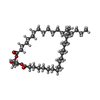 ChemComp-DGA:  ChemComp-PLM: 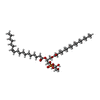 ChemComp-PGV: 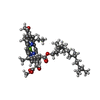 ChemComp-BCL: 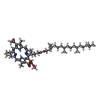 ChemComp-BPH:  ChemComp-UQ8: 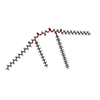 ChemComp-CDL:  ChemComp-FE:  ChemComp-MQ8:  ChemComp-CRT: 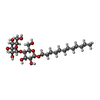 ChemComp-LMT:  ChemComp-CA: 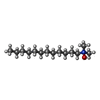 ChemComp-LDA:  ChemComp-HOH: |
| Source |
|
 Keywords Keywords | PHOTOSYNTHESIS / LH1-RC COMPLEX / PURPLE BACTERIA |
 Movie
Movie Controller
Controller Structure viewers
Structure viewers About Yorodumi Papers
About Yorodumi Papers




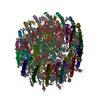
 allochromatium tepidum (bacteria)
allochromatium tepidum (bacteria)